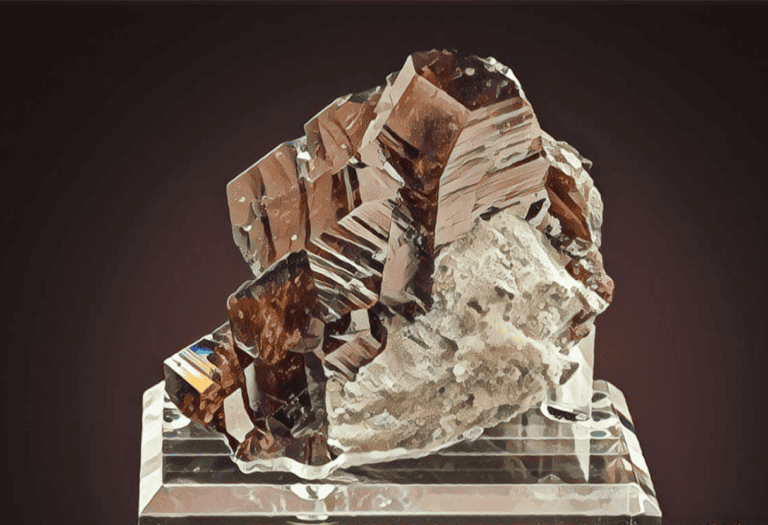Ever found yourself marveling at the deep celestial blue of a gemstone and wondered if it’s the real deal?
Lapis lazuli, with its signature hue, has been captivating humans for millennia.
But in a world full of imitations, knowing how to spot genuine lapis lazuli is a skill you’ll want to have up your sleeve.
To identify genuine lapis lazuli, examine its deep blue color, golden pyrite flecks, and white calcite streaks. Perform a light blue streak test and check for slight magnetic response due to pyrite. Genuine lapis has a Mohs hardness of 5-5.5 and a specific gravity of 2.7-2.9.
How to Identify Lapis Lazuli Through Testing
When it comes to verifying the authenticity of lapis lazuli, certain tests can be quite revealing. Here’s how to assess whether you’ve got the real deal.
Visual Inspection
The first step is always a thorough visual inspection. Look for a deep, consistent blue color with naturally occurring flecks of pyrite. These flecks resemble gold specks and are a telltale sign of authentic lapis lazuli. Moreover, the presence of calcite might manifest as white streaks. Imitations often miss these subtle details.
The Streak Test
The streak test is simple yet effective. Rub the stone across an unglazed porcelain tile and examine the color of the streak it leaves behind. Genuine lapis lazuli will produce a light blue streak. If the streak is any other color, you might be dealing with an imitation.
Magnet Test
Running a magnet over the surface can also provide clues. Lapis lazuli itself isn’t magnetic, but the iron in the pyrite inclusions might cause a slight reaction. If there’s a strong magnetic pull, it’s likely you have a synthetic or altered stone in your hands.
Hardness Test
Lapis lazuli is relatively soft, ranking about 5-5.5 on the Mohs hardness scale. Use a knife or a glass plate to see if the stone can be scratched. If it scratches glass easily or can’t be scratched by a knife, it’s likely not true lapis lazuli.
Birefringence Test
Birefringence refers to the splitting of a ray of light into two paths. True lapis lazuli is an isotropic gem, meaning it has no birefringence. Under a polariscope, an imposter stone might display double refraction, indicating it’s not genuine lapis lazuli.
Checking The Diaphaneity
Lapis lazuli’s diaphaneity ranges from transparent to opaque, with most high-quality pieces leaning towards opaque. Hold your stone up to a light source; you shouldn’t see much light passing through.
Single or Double Refraction
As mentioned, lapis lazuli does not exhibit double refraction. If viewed through a dichroscope, a genuine piece will not show two distinct colors. Any displays of double colors suggest the stone is not authentic lapis lazuli.
Refractive Index Test
Use a refractometer to measure the refractive index of your stone. Genuine lapis lazuli has a refractive index between 1.50 and 1.52. Values deviating significantly from this range might indicate a counterfeit.
Finding The Specific Gravity
The specific gravity of lapis lazuli is approximately 2.7 to 2.9. To determine this, you’ll need to weigh the stone in the air and then suspended in water. The results might require some calculations, but this test is quite indicative of authenticity.
Identifying Lapis Lazuli in the Field
If you’re looking for lapis lazuli in the field, keep an eye out for rocks that bear the rich, royal blue color typical of the stone. These rocks will often be found in metamorphic and limestone areas.
Recognizing Potential Lapis Lazuli Rocks
When prospecting for potential lapis lazuli, search for rocks that lay in host formations known for bearing the gemstone. Check for the characteristic blue hue along with signs of pyrite and calcite—however, be aware that raw lapis lazuli may appear duller and needs polishing to reveal its vibrant color.
Physical Characteristics of Lapis Lazuli

When you’re delving into the world of gemstones, understanding the physical characteristics of lapis lazuli is crucial for identification. Lapis lazuli boasts a distinct deep blue hue, often with white calcite streaks and brassy yellow pyrite flecks. This interplay of colors makes each specimen unique.
Texture and Luster
Lapis lazuli has a distinctive texture which you’ll recognize by its granular to smooth feel. The lustre is crucial too; lapis ranges from matte to a slight sheen, never highly reflective, distinguishing it from similar stones with more gloss.
Density and Hardness
Keep in mind, lapis lazuli is relatively soft, with a hardness of about 5 to 5.5 on the Mohs scale. This means it can be scratched by harder substances, a detail that’s both a identifying feature and a care consideration. The stone’s density is also telling: lapis lazuli’s specific gravity ranges between 2.7 to 2.9, heavier than average for a mineral its size.
- Color intensity may vary
- Pyrite inclusions are common
- White streaks from calcite
By familiarizing yourself with these key physical traits, you’ll be well-equipped to identify genuine lapis lazili stones. Remember, it’s the combination of characteristics like color, texture, and density that often reveal a stone’s true identity.
How Are Lapis Lazuli Formed?
Lapis lazuli is not your typical gemstone; it’s actually a rock composed of multiple minerals. Primarily, lazurite, calcite, sodalite, and pyrite merge to create the iconic look of lapis lazuli. This formation process is complex and takes millions of years.
Deep within the Earth’s crust, under extreme heat and pressure, these minerals crystallize. The lazurite gives lapis its characteristic deep blue color. Other minerals like calcite appear as white streaks and pyrite as golden flecks add depth and interest to each stone.
Most lapis lazuli deposits are sourced from metamorphic rocks. These are rocks that have been fundamentally transformed by intense heat and pressure over vast periods. During metamorphic processes, minerals re-crystallize without melting, allowing lazurite and other components to consolidate into the lapis lazuli.
One fascinating aspect of lapis formation involves the role of hydrothermal fluids. These hot solutions escape from magma and can alter the composition and texture of rocks they penetrate, depositing minerals as they go. It’s these fluids that often facilitate the growth of lazurite crystals.
Mining areas for lapis lazuli are quite limited, with the most renowned source being the Sar-e-Sang mines in Afghanistan. These mines have been a source for lapis for thousands of years, indicating the long-standing value and desirability of this gemstone. Other notable sources include Chile and Russia, each with their own unique geological formations contributing to subtle variations in the stone’s appearance.
Preparation for Lapis Lazuli Hunting
When you set out to find your own piece of the radiant blue treasure that is lapis lazuli, preparation is key. Your success in lapis lazuli hunting hinges heavily on your ability to recognize the right environments for this mineral’s occurrence and being equipped with the right tools and knowledge.
Gathering the Right Tools
To begin your quest for lapis lazuli, you’ll need to assemble a toolkit that aids in both identification and extraction. Here’s what should be in your arsenal:
- Geologist’s hammer – Essential for chipping away rock and extracting samples.
- Safety goggles and gloves – Safety gear to protect your eyes and hands during the hunt.
- Magnifying glass or jeweler’s loupe – A critical tool to closely examine and verify potential lapis lazuli finds.
- Field guide – Bring along a comprehensive field guide that delves into the identification features of lapis lazuli, including its deep blue color, pyrite inclusions, and the white streaks of calcite.
- Water bottle – Spraying water on rocks can make it easier to spot the distinguishing colors and patterns of lapis lazuli.
- Notebook and pen – Document your findings with notes and sketches.
Remember, technology is your ally. GPS devices or smartphone mapping apps help you stay oriented while exploring remote locales known for lapis lazuli deposits.
Safety Considerations
Your safety takes precedence during your treasure hunting endeavors. Keep these safety considerations in mind and prioritize them throughout your expedition:
- Research the area – Know the terrain and weather conditions before you set out. Remote mining areas can be treacherous, and weather can change quickly.
- Inform someone of your plans – Make sure a friend or family member knows where you’ll be and when you expect to return.
- Wear appropriate attire – Sturdy boots, long pants, and a good jacket can protect against sharp rocks and unforgiving elements.
- Bring navigation tools – A compass and maps are essential, even if you have digital tools. Batteries can fail, but traditional navigation aids are fail-safe.
Being aware of local regulations is vital. Certain regions require permits for mineral collection, so adhere to the laws to avoid legal pitfalls. Processing your findings in an environmentally responsible manner also underpins the ethical standards of the rockhounding community.
Handling and Care of Found Lapis Lazuli

After successfully identifying and procuring lapis lazuli, the next crucial step is ensuring that your treasured finds are handled and cared for properly. This involves cleaning, storing, and occasionally, maintaining the vivid blue hue that lapis lazuli is known for.
Cleaning Lapis Lazuli
Proper cleaning is vital to maintain the integrity and appearance of your lapis lazuli stones. Follow these guidelines to clean your finds safely:
- Use mild soapy water and a soft-bristled brush to gently scrub the surface.
- Rinse the stones with cool water to remove any soap residue.
- Pat the lapis lazuli dry with a soft, lint-free cloth or let it air dry.
- Avoid using harsh chemicals or ultrasonic cleaners; these can damage the stone’s surface.
Remember, lapis lazuli is a relatively soft gem, rating between 5 and 6 on the Mohs hardness scale, which means it can easily scratch or be damaged if not handled gently.
Storing Lapis Lazuli
Once your lapis lazuli stones are clean, proper storage is essential to prevent damage. Consider the following tips for storing your lapis lazuli:
- Wrap the stones in a soft cloth or place them in a fabric-lined jewelry box to prevent scratching.
- Keep lapis lazuli away from direct sunlight, as prolonged exposure can fade its color.
- Store your lapis lazuli separately from other gemstones, especially those that are harder on the Mohs scale, to avoid accidental scratches.
- Maintain a stable environment, free from extreme temperatures and humidity, to preserve the stones’ quality.
Your lapis lazuli stones are not just collectibles but often hold sentimental or monetary value. Ensuring they are cleaned and stored correctly will help maintain their condition and keep them looking their best for years to come.
Conclusion: Confirming Lapis Lazuli is Real
You’ve learned the key traits to identify genuine lapis lazuli and understand the importance of proper handling and care.
Remember to gently clean your stone with soapy water and a soft brush and store it with the care it deserves. By keeping it away from harsh sunlight and chemicals you’ll ensure its longevity and preserve its deep celestial blue for years to come.
Trust in your newfound knowledge and enjoy the beauty and history that lapis lazuli brings to your collection.


![NY Rockhounding Spots & Finds in [year] : A Beginner’s Guide](https://observationhobbies.com/wp-content/uploads/2024/01/AEUgIv0VNXhpjy1yym9AS-768x439.jpg)
![Alabama Rockhounding Sites in [year]: Fossil & Mineral Spots](https://observationhobbies.com/wp-content/uploads/2024/01/SHOqOO3B-QS16Lqks0Ax9-768x439.jpg)

![Kansas Rockhounding Sites in [year]: Best Spots & Treasures](https://observationhobbies.com/wp-content/uploads/2024/01/MEpyAlU09VN0IV9zhK62K-768x439.jpg)
![Louisiana Rockhounding Sites in [year]: Best Spots & Treasures](https://observationhobbies.com/wp-content/uploads/2024/01/ZdocqQJBdU4beXX3hNxPc-768x439.jpg)
